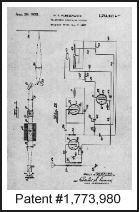In 1933, after Farnsworth abruptly terminated his arrangement with Philco and struck off once again on his own, he resumed his efforts to find another company willing to support his research with a patent license. Much to his consternation, there were no takers. This seemed odd, since clearly, Farnsworth's television system was light years ahead of the competition, most of whom were still experimenting with variations on the Nipkow Disk systems that were developed in the '20's.
Through contacts in the industry, Farnsworth and his backers learned why none of the most likely candidates would offer Farnsworth a license for his patents. All these companies were actively engaged in the manufacture of radio equipment, and so were dependent on patent licenses with the Radio Corporation of America for their livelihood. As RCA chief David Sarnoff liked to say in closed quarters, "The Radio Corporation does not pay patent royalties, we collect them," and the companies that Farnsworth was approaching were the very companies that paid RCA those royalties. And through their sources, Farnsworth's people learned that RCA had issued another unwritten edict to their licensees: work with Farnsworth, and their radio patent licenses would be terminated.
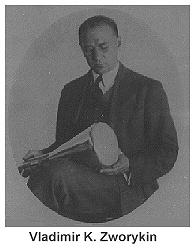 RCA apparently based its position on a deepening relationship
with Vladimir Zworykin and his 1923 patent application. By the
early 1933, Zworykin was demonstrating a camera tube he called
the "Iconoscope." The true origins of the Iconoscope
are dubious at best: some essential components of the device
can be traced to the Hungarian inventor Kalman Tihanyi, and a
similar tube, dubbed the "Emitron," emerged from the
laboratories of EMI in Britain -- an RCA cross-licensee -- about
the same time Zworykin's Iconoscope first appeared in America.
RCA apparently based its position on a deepening relationship
with Vladimir Zworykin and his 1923 patent application. By the
early 1933, Zworykin was demonstrating a camera tube he called
the "Iconoscope." The true origins of the Iconoscope
are dubious at best: some essential components of the device
can be traced to the Hungarian inventor Kalman Tihanyi, and a
similar tube, dubbed the "Emitron," emerged from the
laboratories of EMI in Britain -- an RCA cross-licensee -- about
the same time Zworykin's Iconoscope first appeared in America.
Regardless of its questionable origins, the Iconoscope was the device upon which Sarnoff was determined to extend his empire and go down in history as the man who gave television to the world. Even though there was not yet an actual patent for the Iconoscope -- only the still-open patent application from 1923 -- RCA's attorneys went so far as to assert behind-the-scenes that the Iconoscope had priority over the Image Dissector, and that Farnsworth's patents infringed on Zworykin's application. On the basis of this flimsy claim, RCA threatened behind the scenes to put any body who did business with Farnsworth out of business.
Realizing the bind they were in, Farnsworth and his backers did the only thing they could do: they mounted a challenge before the examiners of the U.S. Patent Office.
Accepting Farnsworth's challenge made perfect sense from Sarnoff's point of view: Not only did RCA have a perfect record of defeating lesser adversaries in patent litigation, but the company was spending money on television at TEN TIMES the rate that Farnsworth was spending. Sarnoff needed a quick retum on all that investment in order to preserve his reputation and calm the rumblings on his board of directors. Surely , the fledgling Farnsworth organization seemed like yet another easy target for the formidable legal forces of "the Radio Corporation."
The ensuing interference proceedings focused primarily on Claim 15 of Farnsworth's 1930 patent #1,773,980, which describes the simple, elegant concept of an "electrical image," which is the critical step in the process of converting light into electricity. There is something slightly intangible embodied in the precise wording of Claim 15 which reveals the indispensable process of creating an electrical counterpart of an optical image, in which values of electricity correspond to values of light. Claim 15 calls it:
An apparatus for television which comprises means for forming an electrical image, and means for scanning each elementary area of the electrical image, and means for producing a train of electrical energy in accordance with the intensity of the elementary area of the electrical image being scanned.
This paragraph, first composed in 1927, announces the arrival of television on this planet, and is essentially the idea that 13-year-old Philo T. Farnsworth pictured in his mind's eye that hot afternoon five years earlier while he tilled the potato fields in Rigby Idaho. This paragraph describes the essence of Farnsworth's invention, the missing ingredient, which, once found, paved the way for television as we now know it. Yet in 1934, RCA's attorneys tried to prove that Zworykin had the idea first.
Farnsworth spent many weeks answering an endless inundation of questions posed by a battery of RCA's biggest legal guns. Literally reams of testimony were taken. Every stack of depositions meant another week that Farnsworth was kept out of his laboratory, another week of progress lost to the competition.
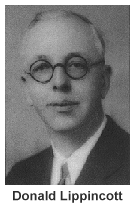 The champion of Farnsworth's case was a sharp young attorney,
Donald K. Lippincott, who was every bit as much an engineer as
he was a lawyer. Lippincott held Phil and his abilities in great
esteem; For his part, Phil regarded Don as "urbane without
being Eastern." Together the two saw right through RCA's
semantic charades and chipped away at RCA's case. They built clear
concise and uncompromising arguments that methodically demolished
RCA's claim.
The champion of Farnsworth's case was a sharp young attorney,
Donald K. Lippincott, who was every bit as much an engineer as
he was a lawyer. Lippincott held Phil and his abilities in great
esteem; For his part, Phil regarded Don as "urbane without
being Eastern." Together the two saw right through RCA's
semantic charades and chipped away at RCA's case. They built clear
concise and uncompromising arguments that methodically demolished
RCA's claim.
Farnsworth and Lippincott delivered a dramatic tour-de-force when RCA challenged Phil's claim that he had first thought of his approach to electronic television while he was a high school freshman in Rigby, Idaho. RCA's attorneys greeted this assertion with a laugh - how could a mere child possibly dream up something as intricate as electronic television? Certain that Farnsworth couldn't possibly support this bold contention, the opposition pressed the point.
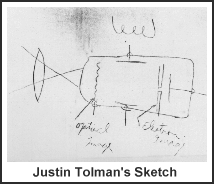 RCA's disbelief started to crumble when Lippincott and one RCA
attorney went to Salt Lake City and tracked down Justin Tolman.
Tolman recalled clearly the day that his young student drew a
series of diagrams on the blackboard in Rigby. Then to the amazement
of both Lippincott and the RCA lawyer, Tolman drew from memory
a simple sketch of an electronic tube, which turned out to be
a precise replica of an Image Dissector. The RCA attorney shook
his head in silence as he handed the drawing back to Lippincott.
RCA's disbelief started to crumble when Lippincott and one RCA
attorney went to Salt Lake City and tracked down Justin Tolman.
Tolman recalled clearly the day that his young student drew a
series of diagrams on the blackboard in Rigby. Then to the amazement
of both Lippincott and the RCA lawyer, Tolman drew from memory
a simple sketch of an electronic tube, which turned out to be
a precise replica of an Image Dissector. The RCA attorney shook
his head in silence as he handed the drawing back to Lippincott.
Despite the gravity of the case at hand, RCA's case was surprisingly weak. There was no effort to produce into evidence a tube from 1923 that would substantiate Zworykin's claim to have had an operable television transmitter at that time. There were some vague verbal accounts, and those were dismissed by the examiners as unreliable, having been "influenced by later events and knowledge." In other words, when it mattered most, RCA was either unwilling or unable to produce the evidence that would today support Zworykin's claim to have invented the Iconoscope -- or something like it -- in 1923.
In April of 1934, the United States Patent Office delivered its first milestone decision in the case of Zworykin vs. Farnsworth. In its final ruling in case #64, 027, the patent examiners summarily dismissed RCA's claim in terms that spoke almost derisively of RCA's entire presentation, saying in conclusion:
1. That Zworykin has no right to make the count by virtue of the specific definition of the term "electrical image" given in the Farnsworth patent;2. Zworykin has no right to make the count because it is not apparent that the device would operate to produce a scanned electrical image unless it has discrete globules capable of producing discrete space charges and the Zworykin application as filed does not disclose such a device {note: this clause basically states that the device disclosed in 1923 could NOT have been an Iconoscope... but we'll come back to that later...}
3. That Zworykin has no right to make the count even if the device originally disclosed operates in the manner now alleged by Zworykin because this alleged mode of operation does not produce an electrical image that is scanned to produce the television signals.
After a few more pages of legal discourse, the decision ends with an unequivocal declaration:
"Priority of invention is awarded Philo T. Farnsworth."
Unfortunately, this resounding proclamation was followed by one more little sentence: "Limit of Appeal: August 22, 1935. In other words, RCA had sixteen months to appeal the decision. With no money left to carry on the fight if RCA did appeal, Farnsworth and his backers waited, holding their breath everyday of those sixteen months. On the last possible day, RCA filed their appeal. This appeal was eventually denied, but the die was now cast: Farnsworth's entanglements with RCA went on for years, and placed the future of television in a state of suspended animation.
Things took a brighter turn in the summer of 1934, when the prestigious Franklin Institute of Philadelphia invited Philo T. Farnsworth to conduct the world's first full scale public demonstration of television.
Encouraged as he was by the steadily improving performance of the Image Dissector, Farnsworth accepted the invitation, and disregarded for the time being his stalemate with RCA. After all, the future of television belonged not with any single corporation, but with the people, the audience that would buy television sets and watch television programs. Farnsworth hoped to score some points with the public by being the first to show them what they could expect.
While Farnsworth was preparing for the Franklin Institute exhibit, he was introduced to Russell Seymour Turner, known to his friends as "Skee." Turner was an engineer and businessman whose wealthy father had acquired a healthy chunk of the Farnsworth stock that George Everson and Jess McCargar continued to sell to raise funds for the ongoing research. Skee was sent in to see what he could do to push the enterprise closer to some sort of pay off. Skee was smitten immediately with the Farnsworth charm, and began to take a strong personal interest in Phil and the things that he had to offer.
Turner saw to it that Farnsworth had enough funds to build a completely new system for the Franklin Institute exhibit. The picture tube that Cliff made was the size of a ten gallon jug and the camera was compact even by today's standards. So equipped, Farnsworth was handsomely prepared to introduce his invention.
The exhibit was an unprecedented success. There was little advanced publicity - only word-of-mouth -but people were lined up for blocks when the doors opened in August, 1934. The response was so strong that the event, which was originally scheduled to last ten days, went on day and night for three weeks.
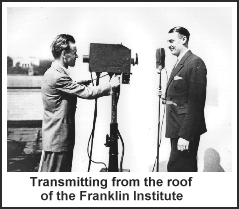 Farnsworth placed one camera unit near the door, and the power
of his invention was instantly driven home to anyone who entered,
as they were immediately confronted by their own disembodied image
flickering across the bottom of a ten gallon bottle.
Farnsworth placed one camera unit near the door, and the power
of his invention was instantly driven home to anyone who entered,
as they were immediately confronted by their own disembodied image
flickering across the bottom of a ten gallon bottle.
Programs were thrown together spontaneously and transmitted from the roof to an auditorium downstairs. Thousands of Philadelphians poured through the auditorium in 15 minute intervals to see what ever was appearing. Vaudeville acts, popular athletes and a swarm of politicians volunteered to appear before Farnsworth's cameras.
The crowds were totally ambivalent to the content. They came to see the image on the screen, whatever it was. They came to witness the ancient dream of seeing at a distance. For the Depression-weary populace, this was something really new - something that spoke of a future, an oracle of better times to come.
Their success at the Franklin Institute was a terrific morale booster for Farnsworth and his men. It was their first contact with so large an audience, their first undeniable proof of how big television was going to be.
The Franklin Institute demonstration attracted considerable international attention, and marked the beginning of a steady flow of foreign visitors to Farnsworth's lab at 127 Mermaid Lane in the Philadelphia suburbs. Scientists and dignitaries from all over the world came to see the miracle in Farnsworth's living room. Phil and Skee Turner learned a great deal from their guests about the state of television around the world. They were particularly interested in stories about England, where the BBC had been conducting experimental video broadcasts for some years.
The system that the BBC was using was a mechanically scanned device that was invented by a Scotsman named John Logie Baird. Baird's first successful visual transmissions occurred in 1926, when he sent some semblance of the head of a dummy from one room to another. Some years later Baird convinced a reluctant BBC to permit him to use their channels in the evenings to broadcast blurry programs to a handful of receivers. By 1934, Baird had sold more than 20,000 "Televisor" receivers in kit-form all over Europe. Still, the BBC was disappointed in the quality of Baird's picture and started looking for something better.
In the early Thirties, Baird's fortunes fell into the hands of a large British holding company called British Gaumont. Feeling that they had a considerable investment to protect, British Gaumont pushed Baird to abandon his mechanically scanned Televisor in favor of electronically scanned video. British Gaumont reasoned that if the BBC wanted electronic video, then Baird should be the one to provide them with it, even if that meant taking a license with another inventor.
As providence would have it, Baird's people learned of a young inventor in America who was offering just such a license, and quickly dispatched a group of engineers to Philadelphia to see what the boy had to offer.
Philo Farnsworth and Skee Turner received the news of a possible license from Baird with tremendous excitement - a license in England could be the prelude to a whole series of licenses all over Europe. On arrival in Philadelphia, the English engineers were instantly impressed with Farnsworth's system, and at their invitation arrangements were made to take Farnsworth and his invention to England, where negotiations would be concluded.
Phil and Skee reveled in the unexpected change of fortunes. At last it seemed there was new hope for television. So Philo T. Farnsworth carefully crated up his circa 1934 television "mobile unit" and sailed for Southampton, hoping to accomplish in Europe what he could not accomplish in America.
